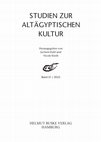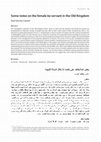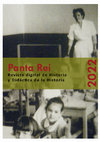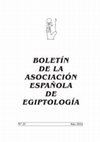Papers by Raúl Sánchez Casado

Cuadernos de Prehistoria y Arqueología de la Universidad Autónoma de Madrid, 2024
This work analyses the figure of Djefaided, overseer of the ka‑servants in the necropolis of El‑H... more This work analyses the figure of Djefaided, overseer of the ka‑servants in the necropolis of El‑Hammamiya during the Fifth Dynasty. Throughout the study of his tomb (A1) and that of the masters he served (Kaikhenet A2 and Kaikhenet A3), we can understand his role in the funerary cult developed in the necropolis, his socioeconomic status and the relationships of interdependence and patronage in which he was integrated. The figure of Djefaided is revealed as an exceptional case study to understand the impact that the establishment and man‑agement of the funerary cult had for the people who took care of its maintenance. The tombs of El‑Hammamiya show an especially clear example of how the offering service played an important role as a system of social or‑ganization and a method of economic redistribution during the Old Kingdom.

Journal of Egyptian History
This paper focuses on the figure of the overseer of linen (jmj-r sšrw) during the chronological p... more This paper focuses on the figure of the overseer of linen (jmj-r sšrw) during the chronological period of the Old Kingdom. By choosing a wide selection of sources, we have undertaken the reconstruction of the main features that defined this title, looking in-depth at the specific roles associated with it and the contexts in which they were exercised. The nature of the sources has meant that we have taken a mainly iconographic approach, which, combined with textual and archaeological analysis, has allowed us to get the most out of the evidence available. Thus, the jmj-r sšrw is revealed as an essential character in the Old Kingdom household, overseeing the supply, storage, and distribution of linen within the estate. Additionally, the supervision of a product that is key for the well-being of the deceased in the netherworld granted the jmj-r sšrw an important role in the funerary cult of their deceased master, who aimed to ensure his eternal supply of linen.
Memoria y Civilización
En las sociedades antiguas donde convivían múltiples comunidades religiosas de antigua raigambre ... more En las sociedades antiguas donde convivían múltiples comunidades religiosas de antigua raigambre resulta de especial interés el estudio de la interacción producida en el plano de las creencias y prácticas funerarias. En este sentido, el presente trabajo pretende estudiar los orígenes de un motivo religioso que aparece en algunos de los ajuares funerarios de tradición osiriana en el Egipto romano, consistente en la momificación del difunto bajo el cielo como manto.
Chronique d’Égypte XCVIII , fasc. 195-196, 2023

Journal of Egyptian History, 2023
This paper focuses on the figure of the overseer of linen ( jmj-r sšrw) during the chronological ... more This paper focuses on the figure of the overseer of linen ( jmj-r sšrw) during the chronological period of the Old Kingdom. By choosing a wide selection of sources, we have undertaken the reconstruction of the main features that defined this title, looking in-depth at the specific roles associated with it and the contexts in which they were exercised. The nature of the sources has meant that we have taken a mainly iconographic
approach, which, combined with textual and archaeological analysis, has
allowed us to get the most out of the evidence available. Thus, the jmj-r sšrw is revealed as an essential character in the Old Kingdom household, overseeing the supply, storage, and distribution of linen within the estate. Additionally, the supervision of a product that is key for the well-being of the deceased in the netherworld granted the jmj-r sšrw an important role in the funerary cult of their deceased master, who aimed to ensure his eternal supply of linen.

Studien zur Altägyptischen Kultur, 2022
The present report presents the archaeological, epigraphic, conservation, and landscape works car... more The present report presents the archaeological, epigraphic, conservation, and landscape works carried out by the Middle Kingdom Theban Project-a project under the auspices of the University of Alcalá (UAH, Madrid) Expedition to Deir el-Bahari and Asasif-in three campaigns (Fifth Season 2020, Study Season 2021, Sixth Season 2021). After the abrupt interruption of the Fifth Season due to the outbreak of the SARS-COVID 19 pandemic, the team organized a (summer) Study Season (Summer 2021), mainly to complete the analysis and documentation of required materials, and the Sixth Season (Fall 2021), where the focus stood on: i) the excavation of the courtyards of Henenu (TT 313) and Ipi (TT 315); ii) the excavation of the inner sections of TT 313 and E1; iii) the epigraphic analysis of hundreds of relief blocks retrieved from TT 313; iv) the implementation of new conservation protocols for the findings as well as the anal sis of the conservation conditions and problems in agi s tomb and v) the detailed analysis of textiles, ceramics, and human remains from TT 315.

The Present of Antiquity: reception, recovery, reinvention of the Ancient World in current popular culture, 2019, ISBN 978-2-84867-714-9, págs. 27-47, 2019
Compte tenu de l'importance que la religion et ses principaux acteurs, à savoir les prêtr... more Compte tenu de l'importance que la religion et ses principaux acteurs, à savoir les prêtres, ont pu jouer dans l'Égypte ancienne, la vision cinématographique du pays du Nil est restée intimement liée à cette dernière. En raison de cette circonstance, le présent travail propose une approche sur la façon avec laquelle le cinéma a représenté le sacerdoce égyptien, selon deux points de vue: son iconographie et son rôle dans la trame. C'est pour cda qu'ont été sélectionnées une série de séquences de différents films, qui sont commentées à la lumière de la documentation égyptologique, principalement afin de déterminer leur degré de fidélité historique, tout en évaluant comment les clichés qui existent dans l'imaginaire collectif ont affecté la vision qu'offre le passé égyptien sur le grand écran.
Actas del V Congreso Ibérico de Egiptología: V Congreso Ibérico de Egiptología, Cuenca, 9 a 12 de marzo de 2015, 2017, ISBN 978-84-9044-240-1, págs. 975-986, 2017
Studien zur Altägyptischen Kultur, 2017
This report presents the archaeological, epigraphic, conservation and site management activities ... more This report presents the archaeological, epigraphic, conservation and site management activities carried out by the Middle Kingdom Theban Project – a project under the auspices of the Freie Universität Berlin Mission to Deir el-Bahari – in the first two seasons (2015–2016). The two initial seasons have provided abundant material for the researchers to investigate the origin, history, and role of the early Middle Kingdom necropolis in the northern hills of Deir el-Bahari, its tombs and elite officials buried there, and shall shed light on the history, society, and religion of the period initiated by Mentuhotep II at Thebes at the end of the Eleventh Dynasty.

espanolEn este articulo se analizan tres conjuntos de fuentes que nos permiten acercarnos al pape... more espanolEn este articulo se analizan tres conjuntos de fuentes que nos permiten acercarnos al papel jugado por los servidores del "ka" en algunos de los procedimientos legales del Reino Antiguo. En primer lugar, a traves de una tipologia de clausula incluida en las disposiciones de establecimiento del culto funerario, examinamos su vinculacion en la resolucion de conflictos dentro de la propia institucion de los "ḥmw-kȝ". En segundo lugar, por medio de la iconografia, estudiamos su papel en las llamadas escenas de ‘rendimiento de cuentas’, las cuales muestran su actividad en la fiscalizacion de la actividad de la fundacion funeraria; a la par que detenemos nuestra atencion en una escena particular en la que los "ḥmw-kȝ" aparecen acompanando a un individuo preso, que interpretamos como una posible victima sacrificial humana, real o fingida. Por ultimo, senalamos la actuacion de los servidores del ka como testigo en la firma de documentos legales. EnglishI...
Studien zur Altägyptischen Kultur, 2016
This report presents the archaeological, epigraphic, conservation and site management activities ... more This report presents the archaeological, epigraphic, conservation and site management activities carried out by the Middle Kingdom Theban Project – a project under the auspices of the Freie Universität Berlin Mission to Deir el-Bahari – in the first two seasons (2015–2016). The two initial seasons have provided abundant material for the researchers to investigate the origin, history, and role of the early Middle Kingdom necropolis in the northern hills of Deir el-Bahari, its tombs and elite officials buried there, and shall shed light on the history, society, and religion of the period initiated by Mentuhotep II at Thebes at the end of the Eleventh Dynasty.

The iconographic repertoire of the Old Kingdom tombs seems to show that the funerary cult during ... more The iconographic repertoire of the Old Kingdom tombs seems to show that the funerary cult during this period was developed by an important number of people that were able to hold a wide variety of titles. Among those, there is one that looms as particularly frequent: the Hm-kA. Usually known as the ka-servant or ka-priest, this title is almost omnipresent in Old Kingdom tombs. His main function was to satisfy the necessities of his deceased lord by providing his funerary cult with all kinds of offerings. However, in order to ensure the proper functioning of the cult and its supply, they also developed functions in the management of the properties allotted to its finance. The service of the ka was considered by ancient Egyptians as a communitarian system composed of several members, including women also. This circumstance makes the Hmt-kA one of the few female ritualists in the Old Kingdom. In this paper, I have aimed to shed light upon the position of the female ka-servants in relat...

Panta Rei.
The mortuary provisions of private tomb owners in the Old Kingdom constitute fundamental evidence... more The mortuary provisions of private tomb owners in the Old Kingdom constitute fundamental evidence for the understanding of the operation of the private mortuary cult. The clauses present in these texts provide information about a variety of topics concerning the development of the cult and the use of the properties allotted to sustaining it. However, there are some aspects about which not much information is given. One of these facets is the way in which the goods allocated for the mortuary cult were distributed among the cultic performers. In this paper I intend to contribute to clarifying this aspect by analysing three case studies that are particularly revealing about this matter. Las disposiciones funerarias de los propietarios de tumbas del Reino Antiguo constituyen una evidencia fundamental para la comprensión de los sistemas de funcionamiento del culto funerario de los particulares. Las cláusulas presentes en esos textos nos proporcionan información sobre el desarrollo del cu...

Panta Rei: revista digital de Historia y didáctica de la Historia, 2022
The aim of this paper is to clarify one of the lesser-known aspects in the operation of t... more The aim of this paper is to clarify one of the lesser-known aspects in the operation of the mortuary cult in the Old Kingdom: the way in which thegoods allocated for sustaining the cult were distributed among the cultic performers. In order to accomplish our objective, we have analyzed three case of mortuary provisions that are particularly illustrative for our subject of study. The combined information of these three texts sheeds light on a panorama that would have been tremendously varied and adaptive. With greater or lesser accuracy, the private owners would have tried to imitate the organization of the royal mortuary cult, but this system would have been a costly privilege that coexisted with more modest arrangements. Regardless of the structure, the division of the goods among officiants appears to have been primary linked to time served. Although, as we will show, the distribution systems were more complex than a mere equitable division among the members.

This report presents a brief description of the archaeological, epigraphic, conservation and site... more This report presents a brief description of the archaeological, epigraphic, conservation and site management activities carried out by the Middle Kingdom Theban Project —a project initiated under the auspices of the Freie Universität Mission (FUB) at Deir el-Bahari— in the BAEDE, Boletín de la Asociación Española de Egiptología, núm. 25, 2016, págs. 89-112, ISSN: 1331-6780 BAEDE, no 25, 2016, 89-112, ISSN: 1331-6780 89 BAEDE, no 25, 2016, 89-112, ISSN: 1331-6780 A. J. MORALES, S. FALK, M. OSMAN, R. SÁNCHEZ, H. SHARED, K. YAMAMOTO y E. H. ZIDAN 90 first two seasons (2015-2016). The project shall be carried out in the next seasons with the support of the Universidad de Alcalá (UAH). The two initial seasons have provided significant evidence to the team for investigating the origin, history, and role of the early Middle Kingdom necropolis in the northern hills of Deir el-Bahari, its tombs, and elite officials buried there, and should help to comprehend the political history, social con...











Uploads
Papers by Raúl Sánchez Casado
approach, which, combined with textual and archaeological analysis, has
allowed us to get the most out of the evidence available. Thus, the jmj-r sšrw is revealed as an essential character in the Old Kingdom household, overseeing the supply, storage, and distribution of linen within the estate. Additionally, the supervision of a product that is key for the well-being of the deceased in the netherworld granted the jmj-r sšrw an important role in the funerary cult of their deceased master, who aimed to ensure his eternal supply of linen.
approach, which, combined with textual and archaeological analysis, has
allowed us to get the most out of the evidence available. Thus, the jmj-r sšrw is revealed as an essential character in the Old Kingdom household, overseeing the supply, storage, and distribution of linen within the estate. Additionally, the supervision of a product that is key for the well-being of the deceased in the netherworld granted the jmj-r sšrw an important role in the funerary cult of their deceased master, who aimed to ensure his eternal supply of linen.
Dear CRE colleague: We are very excited to present our candidature for We hope that you contemplate the CRE 2019! fascinating possibilities that Alcalá (Madrid) can offer for the next CRE meeting.
resolución de conflictos dentro de la propia institución de los Hmw-kA. En segundo lugar, por medio de la iconografía, estudiamos su papel en las llamadas escenas de ‘rendimiento de cuentas’, las cuales muestran su actividad en la fiscalización de la actividad de la fundación funeraria; a la par que detenemos nuestra atención en una escena particular en la
que los Hmw-kA aparecen acompañando a un individuo preso, que interpretamos como una posible víctima sacrificial humana, real o fingida. Por último, señalamos la actuación de los servidores del ka como testigo en la firma de documentos legales.
ABSTRACT: In this paper, three distinctive groups of evidence are presented with the aim to analyze the role played by the ka-servant in certain legal procedures of the Old Kingdom. At first, based on a specific kind of clause found in the funerary contracts, we examine the relationship of the ka-servant with the procedure of dispute resolution within the institution of the Hmw-kA. At second, by means of an iconographic analysis, we studied
his role in the so-called scenes of ‘rendering accounts’, which show it activity in the oversight of the funerary estate; At the same time, we focus in a particular scene which shows the Hmw-kA conducting a prisoner, that I interpreted as a possible sacrificial human victim, real or fictive. At last, we point out the action of the ka-servants as witness in the signing of legal documents.
Table of Contents and initial pages: bit.ly/InitialPagesMOA3
In spite of its origin as a tomb for the vizier, the tomb of Dagi was extensively reused in later times, as happened with tombs all over the area of Deir el-Bahari. But the most relevant phase of reoccupation of the monument occurred in the Coptic period, when part of the primitive structure was integrated into the monastery of Epiphanius. Although it is difficult to provide absolutely certain dates, we know that the monastery was fully operational as early as the middle of the sixth century.
The aim of our paper is to analyse the structures associated with Dagi’s tomb from a diachronic perspective, focusing on the understanding of its evolution and phases of utilization by using an approach that Upton has come to call historical fluidity in Architecture. Given that the building presents at least two key moments in its evolution: its use as a funerary structure in Pharaonic times and its reuse as a monastery of early Christianity in Coptic times, our efforts will focus on the analysis of both phases and on understanding the changes made to adapt the structure for its later use.